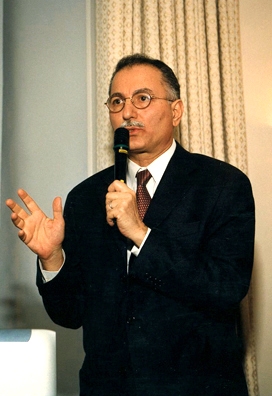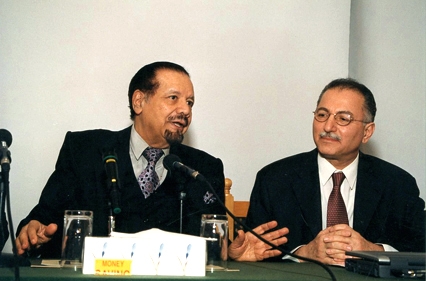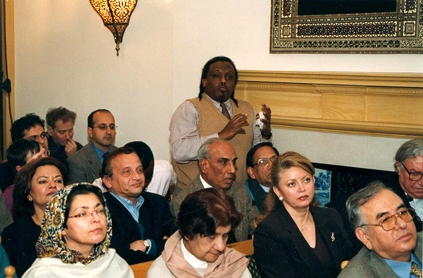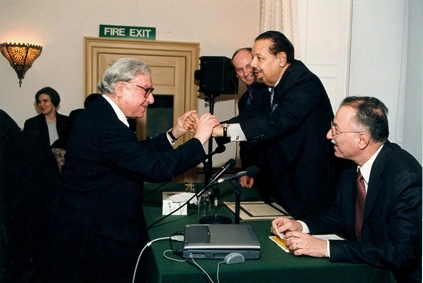On the evening of Thursday, 24th January 2002, a large number of scholars and members of the public interested in culture and the sciences gathered to listen to a lecture by Professor Ekmeleddin Ihsanoğlu, Vice Chairman of Al-Furqan Islamic Heritage Foundation, entitled “Ottoman Science between the Islamic and European Traditions”.

The lecture was illustrated by slides of maps, drawings and images of scholars, schools and books. It covered three main phases in Ottoman history: the formation of the Ottoman state, fusion between the Ottoman and European scientific traditions and finally a synthesis between the two traditions.
Phase I — Formation
After a brief introduction to the history of the Ottoman state, its emergence and development, Professor Ihsanoglu explained that the Ottoman state was born when nomadic tribes, initially confined to a small region, expanded their geographic domain to cover areas of Asia, Africa and Europe. It inherited the Muslim scientific movement as well as the traditions of knowledge among those peoples living within the lands of the new state, including urban centres where scientific traditions were established and flourishing.

The Ottomans inherited the cultural heritage of the Seljuks and established schools in Anatolia and European Rumilia. They also benefited from the sciences of astronomy and mathematics of the Timur empire, and from the medical and Islamic scholastic traditions of Egypt. The Ottoman sultans were keen to support scientific endeavour and sponsor scientists and scholars. They brought them to the urban heart of the empire in Constantinople following its conquest, when its name was changed to “Istanah”. Schools were built including, for the first time, an academic medical school independent of a hospital. Libraries flourished and scholars, for example Taqi al-Din al-Falaki and his colleagues, came to the fore and produced important works, such as calculations of the sun’s movements and eclipses that are close to those arrived at by modern science. Their work demonstrates the advances made by scientists in the Ottoman empire.
Phase II — Fusion
Evidence reveals that the Ottoman empire was the first oriental power to make contact with the modern scientific movement in Europe at the onset of the Renaissance. While scholars dedicated themselves to acquiring knowledge and benefiting from the Muslim scientific heritage in the fields of medicine, surgery and chemistry, they also studied modern European scientific methodologies and scientific advances made in Europe. Students were dispatched to Europe, specialised scientific books were translated into Turkish from Latin, French and English, and modern scientific institutes were set up which included engineering, medical and art colleges.]
Phase III — Synthesis
During this phase the achievements of modern European science were fully absorbed by Ottoman science which kept abreast of European developments. While scientists in the first phase of the Ottoman empire had relied primarily on Arabic manuscripts, and to a lesser extent on Persian manuscripts, since few scientific books were available in Turkish, all books during the phase of synthesis were published in Turkish following the establishment of a printing house in the 18th century. In the 19th century, when modern schools were established, Turkish became the language of science though subsequently French became the language for teaching medicine. This was the first time a European language had been used to teach a scientific subject rather than an Islamic language, which can be taken as a sign of approaching modernisation and development in the Ottoman state. Treatises and writings appeared in French alongside books and scientific papers in Turkish.
Science, like all facets of civilisation in the Ottoman state, bore the hallmarks of a harmonious marriage between varying aspects of both Islamic and European cultures. While at its beginning Ottoman scientific endeavour was a continuation of the inherited Islamic scientific traditions, it later developed to attain the height of maturity and efficacy.

Since the Ottoman Islamic state was a European power with vast European domains, it was the first to receive the traditions of modem European sciences once they spread beyond their regional boundaries. Then the Ottomans in their turn helped to transmit modern European scientific traditions to other Islamic countries.

Professor Ekmeleddin Ihsanoglu concluded his lecture by saying: “The Ottoman state successfully combined its Islamic heritage with a modern European approach, playing a leading role in absorbing modern sciences and spreading them inside and outside its own borders.” The lecture was followed by a wide-ranging discussion.

